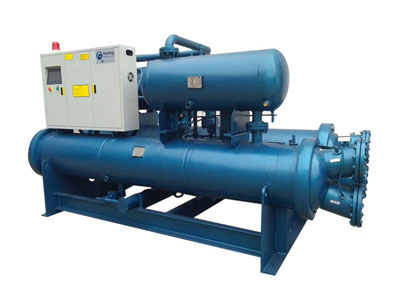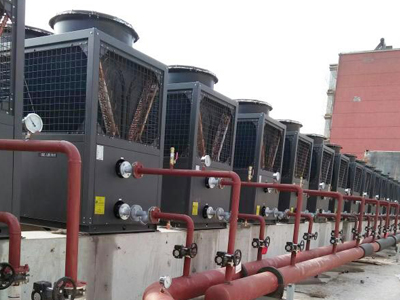How Does an Industrial Chiller Work?
A chiller is a machine that removes heat from a liquid coolant via a vapor-compression, adsorption refrigeration, or absorption refrigeration cycles. This liquid can then be circulated through a heat exchanger to cool equipment, or another process stream (such as air or process water). As a necessary by-product, refrigeration creates waste heat that must be exhausted to ambience, or for greater efficiency, recovered for heating purposes.
Chilled water is used to cool and dehumidify air in mid- to large-size commercial, industrial, and institutional facilities. Water cooled chillers can be liquid-cooled (through cooling towers), air-cooled, or evaporatively cooled. Water or liquid-cooled systems can provide efficiency and environmental impact advantages over air-cooled systems.

Flooded Type Screw Type Chiller
Chillers are widely used as portable cooling systems in commercial and industrial facilities. In simple terms, industrial chillers can be thought of as cooling systems that cool fluids (water cooled chillers) or dehumidify air (air cooled chillers).
Chillers are used to cool equipment quickly and efficiently. By keeping said equipment cool, productivity can continue to be maintained at an optimum level.
It should be noted that although industrial chillers are used to cool equipment components, they do not actually "cool" anything. Industrial chillers do not cool the object, they only remove heat. Our industrial air and water chillers remove the heat from the water or air and circulate it through a heat exchanger to cool the surrounding air or equipment.
In short, you can ultimately think of the chillers we make as heat removal equipment.

Modular Type Air Cooled Scroll Chiller
How do industrial chillers work?
If you were cooking in your kitchen and wanted to cool down the food you were making, you would put it in the fridge. The same idea can be applied to industrial cooling processes. Consider using a chiller as a four-step cycle.
Step 1 - Cooling: To cool your industrial equipment, it must first go through a cooling process. This refrigeration process transfers the heat attached to the equipment and ultimately reduces its temperature.
Step 2 - Evaporation: Once the refrigeration process has started, the heat evaporates with the help of water or air (depending on whether you are using a water-cooled or air-cooled chiller). This evaporation causes the water or air to boil and turn into steam.
Step 3 - Compression: Once the steam has formed, it reaches the compressor, which raises its temperature and pressure.
Step 4 - Condensation: The vapour from the compressor then reaches the condenser, which again lowers the temperature and turns said vapour back into a liquid.
Once it has reached liquid form again, it is metered into the evaporator and the cycle itself is then repeated.
Water-cooled and air-cooled chillers
So far we have discussed two different types of industrial chillers for sale in our post. These types are water-cooled chillers and air-cooled chillers, each with their own advantages and disadvantages.
However, the decision to choose between these two types of portable cooling systems should largely depend on which one is better suited to your company and your investment needs. Let's take a look at how these systems differ.
Water-cooled chillers
The main advantages of using water-cooled chillers.
More accurate heat transfer compared to air-cooled chillers
More energy efficient
Longer service life compared to air-cooled chillers
Main advantages of using air-cooled chillers.
Lower upfront costs
Less space required than water cooled chillers
No water treatment costs, lower maintenance and servicing costs
At Huazhao Refrigeration Equipment, we offer tailor-made industrial cooling systems to meet your company's needs. Contact us today for a bespoke energy efficient chiller solution.

Chilled water is used to cool and dehumidify air in mid- to large-size commercial, industrial, and institutional facilities. Water cooled chillers can be liquid-cooled (through cooling towers), air-cooled, or evaporatively cooled. Water or liquid-cooled systems can provide efficiency and environmental impact advantages over air-cooled systems.

Flooded Type Screw Type Chiller
Chillers are widely used as portable cooling systems in commercial and industrial facilities. In simple terms, industrial chillers can be thought of as cooling systems that cool fluids (water cooled chillers) or dehumidify air (air cooled chillers).
Chillers are used to cool equipment quickly and efficiently. By keeping said equipment cool, productivity can continue to be maintained at an optimum level.
It should be noted that although industrial chillers are used to cool equipment components, they do not actually "cool" anything. Industrial chillers do not cool the object, they only remove heat. Our industrial air and water chillers remove the heat from the water or air and circulate it through a heat exchanger to cool the surrounding air or equipment.
In short, you can ultimately think of the chillers we make as heat removal equipment.

Modular Type Air Cooled Scroll Chiller
How do industrial chillers work?
If you were cooking in your kitchen and wanted to cool down the food you were making, you would put it in the fridge. The same idea can be applied to industrial cooling processes. Consider using a chiller as a four-step cycle.
Step 1 - Cooling: To cool your industrial equipment, it must first go through a cooling process. This refrigeration process transfers the heat attached to the equipment and ultimately reduces its temperature.
Step 2 - Evaporation: Once the refrigeration process has started, the heat evaporates with the help of water or air (depending on whether you are using a water-cooled or air-cooled chiller). This evaporation causes the water or air to boil and turn into steam.
Step 3 - Compression: Once the steam has formed, it reaches the compressor, which raises its temperature and pressure.
Step 4 - Condensation: The vapour from the compressor then reaches the condenser, which again lowers the temperature and turns said vapour back into a liquid.
Once it has reached liquid form again, it is metered into the evaporator and the cycle itself is then repeated.
Water-cooled and air-cooled chillers
So far we have discussed two different types of industrial chillers for sale in our post. These types are water-cooled chillers and air-cooled chillers, each with their own advantages and disadvantages.
However, the decision to choose between these two types of portable cooling systems should largely depend on which one is better suited to your company and your investment needs. Let's take a look at how these systems differ.
Water-cooled chillers
The main advantages of using water-cooled chillers.
More accurate heat transfer compared to air-cooled chillers
More energy efficient
Longer service life compared to air-cooled chillers
Main advantages of using air-cooled chillers.
Lower upfront costs
Less space required than water cooled chillers
No water treatment costs, lower maintenance and servicing costs
At Huazhao Refrigeration Equipment, we offer tailor-made industrial cooling systems to meet your company's needs. Contact us today for a bespoke energy efficient chiller solution.

评论
发表评论